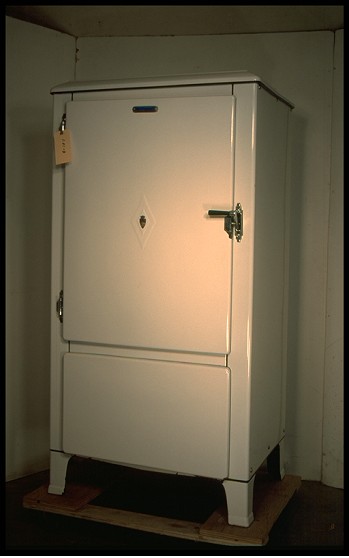Unitary Refrig and A/C Equipment and Systems – Household Cabinet Refrigerators
Sliding crispers, egg racks, butter keepers interior cabinet lights and new easy to operate latching systems were the vanguard of many new amenities which would henceforth drive the field, along with “modern” new styling looks. – An added cabinet feature (not shown in the specification sheet) is an “elbow” operated door latch.
Technical Significance:
Unitary Refrigeration Equipment: The idea of a unitary piece of refrigeration or air conditioning equipment was a significant one in its own right, one that had to wait its time. The scientists, engineers and inventors in the early years of the 20th century were intrigued and obsessed with the power of the technology and of its possible market potential. What they saw was the newly discovered principles of physics and heat engines – following, for example, the early works of Carnot, Faraday, Kelvin, and the later work of Perkins, Larsen and Carrier, to name a few. They understood the promise of the technology for the public good, not to say its consumer sales potential. Early engineering work advanced on a multiple fronts with development of compressors, heat exchangers, valves and piping variously strung together in configurations that would be found to work, but only after much experimentation.
The arrival of unitary equipment, all those parts organised into a single whole, a single unit of construction, a “black box”, that could be offered to the consumer market was a significant technological and cultural event. Technologically the refrigerator would need to be seen to be safe, reliable, maintainable and useful. As well, in order to attract the development capital needed, it must be seen as potentially saleable and affordable, contributing to life’s needs and desires. Its socio- cultural and economic significance was marked, for it would change much. As Canadians we would quickly come enjoy potentially healthier lives, expect new levels of comfort and convenience, with a broader, safer, more diverse and enjoyable diet.
Canadians would quickly come to think of their day differently, for the day would be defined and punctuated in different ways than ever before, as a result of the introduction of modern, electric, household appliances, of which refrigerators, freezers and room air conditioners would be a central part, by the mid 20th century
J. M Larsen produced a manually operated household refrigerator of sorts in 1913, but it was not until 1918 that the Kelvinator Company marketed the first automatic, unitary refrigerator for the home. In that year, it is reported to have sold sixty-seven machines. (See Note 1) The historic artifacts in Group 1.00, Unitary Equipment, including significant samplings the early work of Kelvinator of Canada, provide a rare view of the evolution of unitary refrigeration and air conditioning applications, as they evolved in Canada in the first half of the 20th century.
For those formative years, the artifacts in this Group, 1.00, are typical of the offerings of the Canadian refrigeration and air conditioning industry. They personified the applications found in the homes, farms and commercial premises of the period for, those that could afford life’s new amenities of comfort, convenience and privilege.
This Specimen: The embryonic and early developmental years behind it, Kelvinator’s PK7 marked the beginning of its early growth years in Canada. By the mid 1930’s, in spite of the depression, electric refrigerator had made its mark on the consumer public. By now the electric refrigerator was more stable and quieter in operation with higher speed compressors and spring mounted condensing units and above all new modern styling befitting the period.
Industrial Significance:
The electric refrigerator was, all of a sudden, more attractive in appearance, with gleaming, easy to clean surfaces and fully rounded corners. It clearly had come into its own with its own unique aesthetic. No longer did it appear to the public as a thinly disguised ice box, an image which the public was, by now, quite happy to leave behind. As symbolised here, the PK7 was an important transition point in the development of the industry. Manufactures could see that their continued success would require more than merely well built, efficient and reliable refrigerating machines.
As an increasing number of manufacturers entered the field, the battle for market share was on; customer appeal and features were to become the key to customer sales. One authoritative source reported in 1933 specifications for 24 national manufacturers of household compression cycle refrigerators along with 5 absorption system manufacturers, including Elecrolux of Evansville Ind (See Ref. No. 3.1).


